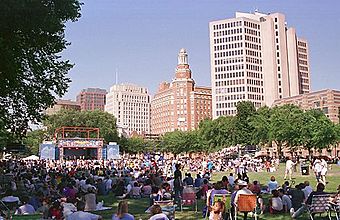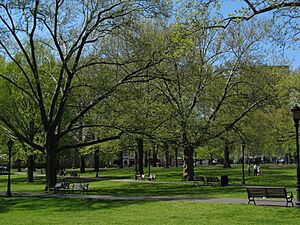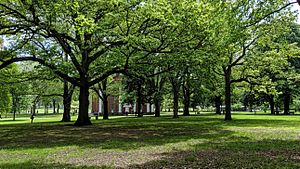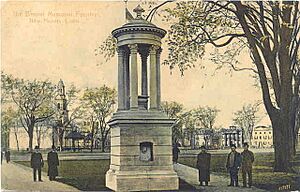New Haven Green facts for kids
|
New Haven Green Historic District
|
|

The Green is a popular venue for festivals
|
|
| Lua error in Module:Location_map at line 420: attempt to index field 'wikibase' (a nil value). | |
| Location | New Haven, Connecticut |
|---|---|
| Built | 1638 |
| Architect | Ithiel Town, David Hoadley |
| Architectural style | Gothic, Federal |
| NRHP reference No. | 70000838 |
Quick facts for kids Significant dates |
|
| Added to NRHP | December 30, 1970 |
| Designated NHLD | December 30, 1970 |
The New Haven Green is a huge, open park in downtown New Haven, Connecticut. It's about 16 acres big, which is like 12 football fields! This park was part of the original plan for the city back in 1638. It was designed by early Puritan settlers.
Today, the Green is surrounded by busy streets: College, Chapel, Church, and Elm. Temple Street cuts through the middle, dividing it into two halves. The Green is a popular spot for many public events. These include the International Festival of Arts and Ideas and the New Haven Jazz Festival. These events can attract hundreds of thousands of people. You can also find people enjoying daily park activities here.
The New Haven Green Historic District is a special place. It was named a National Historic Landmark because of the three beautiful churches built there in the 1800s. The New Haven Green is one of the oldest and most famous town greens in the United States. It has been around since at least 1638. You can even get free Wi-Fi on the Green!
Contents
Exploring the New Haven Green's Past
The Green started as a traditional town common, like a shared village space. It was first called "the marketplace" and was finished in 1638. The Puritans who settled New Haven had a unique idea for its size. They believed it should be big enough to hold 144,000 people. This was the number they thought would be saved in the Second Coming of Christ.
In its early days, the Green was a very busy place. It had a watch house, a prison, and even a school. The First Methodist Church also stood on the upper Green for a time. It was moved in 1848 to a new building across Elm Street. The Green also hosted several statehouses. This was when New Haven shared the role of Connecticut's capital with Hartford. The last statehouse was built in 1837. It was designed in a Greek Revival style by Ithiel Town. But later, Hartford became the only capital, and the building was taken down in 1889.
The Green During the American Revolution
The Green was also a training ground for the New Haven militia. These soldiers, led by Benedict Arnold, quickly went to Massachusetts. They had heard about the Battle of Lexington and Concord. They also fought in the Battle of Bunker Hill during the American Revolution. Because of this, the British attacked New Haven in 1779. They ended up burning most of the city.
Burial Ground History
For its first 150 years, the Green was the main burial ground for New Haven residents. By 1821, burying people there was stopped. Many of the gravestones were moved to the Grove Street Cemetery. However, the bodies themselves were not moved. So, thousands of people are still buried beneath the Green's soil. It's thought that between 4,000 and 5,000 people are buried there. This includes Benedict Arnold's first wife and family members of President Rutherford B. Hayes. Also buried there are Reverend James Pierpont, who founded Yale University, and Theophilus Eaton. Eaton was a founder of New Haven and its governor for 19 years.
In 2012, a big oak tree on the Upper Green fell during Hurricane Sandy. A human skeleton was found tangled in its roots. Police and medical experts were called to the scene. The bones likely date back to colonial times. This was when the Green was used as a cemetery. A small part of the old burial ground is now preserved. It is inside The Center Church Crypt.
Landmarks on the Green
On the upper Green, you'll find three very old churches from the early 1800s. They show the city's religious beginnings. Two of these churches were designed by famous architects, Ithiel Town and Asher Benjamin. One of them was the first large Gothic Revival building in the United States. Because of these important buildings, the Green became a National Historic Landmark in 1970.
The three churches are:
- United Church on the Green: Also called North Church, this building was made in the Federal style. It was designed by David Hoadley in 1814.
- Center Church on the Green: Also known as The First Church of Christ, this church started in 1639. The current building was designed in the Georgian style by Ithiel Town. It was built in 1812. The Center Church Crypt holds the identified remains of about 137 people. It also likely has the remains of over 1,000 unidentified people. Sarah Rutherford Trowbridge has the oldest dated gravestone in the Crypt, from 1687.
- Trinity Church on the Green: This Episcopal church was founded in 1752. It was also designed by Ithiel Town in 1813. It was built between 1814 and 1815. It is known as the first Gothic Style church in the United States. It was officially opened in 1816.
On the lower Green, you can see the Bennett Fountain. It was built in 1907 and looks like an ancient Greek monument. There's also a flagpole with a granite World War I memorial. This memorial was designed by Douglas Orr in 1928. A fountain was added to it in 2003.
The edges of the Green were once covered with beautiful elm trees. These were planted by James Hillhouse. Sadly, most of them died from dutch elm disease. In the 1980s, people worked hard to plant new elm trees. These new trees are resistant to the disease. They help remember the old trees that gave New Haven its nickname, "Elm City."
Buildings Around the Green
Many important buildings surround the Green. These include city buildings, shops, and university structures. Across College Street, on the northwest side, are Yale University buildings. These include Phelps Gate and the Yale Old Campus.
On the southwest side, along Chapel Street, you'll find stores, cafes, and popular restaurants. Across Church Street, on the southeast side, is The Exchange Building. It was built in 1832 and restored in 1990. The Richard C. Lee United States Courthouse is also here. New Haven's Victorian City Hall is at this end of the Green too. It was designed by Henry Austin in 1861.
The Amistad Memorial
The Amistad Memorial is also located near City Hall. It stands where the jail once held the Amistad captives. These captives were Africans who rebelled against slavery on a ship. People used to pay to see them when they were brought out to exercise on the Green.
Across from the eastern corner of the lower Green is the Union and New Haven Trust Building. It was designed in 1927. Its design honors the churches on the Green. It even has a similar cupola to the United Church.
On the northeast side, along Elm Street, is the New Haven Free Public Library. It was built in 1908. Next to the library is the New Haven County Courthouse. This courthouse was designed by local architects. It was inspired by St. George's Hall in Liverpool, England. Statues are in front of the courthouse. Murals and paintings are inside.
Historic Homes on "Quality Row"
The upper Green on Elm Street is bordered by "Quality Row." This area has some of New Haven's oldest homes. The white Nicholas Callahan house was once a tavern. It is now used by the Yale Elihu Senior Society. The Eli W. Blake House and the John Pierpont house are also here. The Pierpont house was built in 1767 and is now the Yale University Visitor Center. The brick Governor Ralph Isaacs Ingersoll House was designed in 1829 by Ithiel Town.






